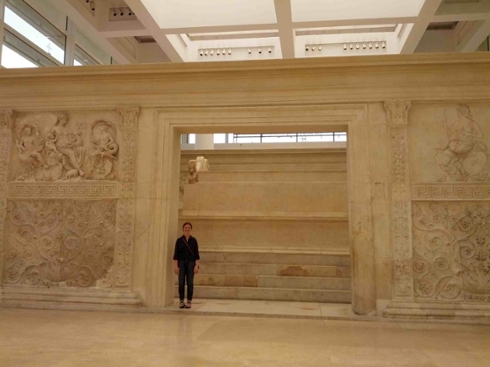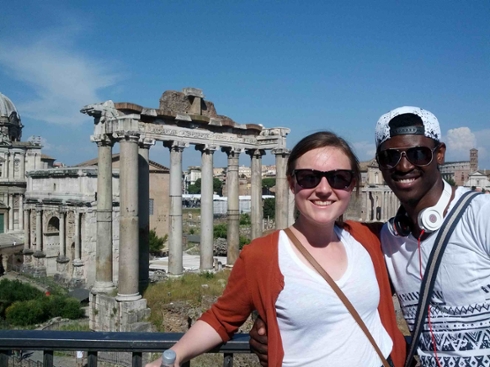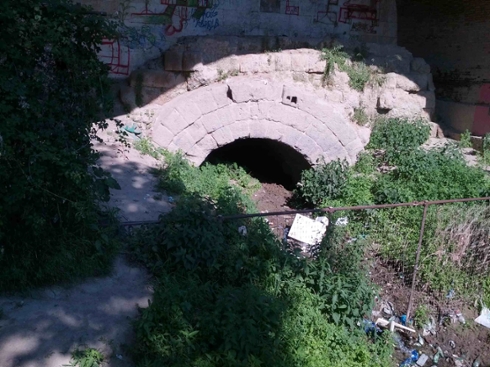Presidents Summer Fellowship 2015: Haley Tilt, Visual Memory and Livy

Right now I’m sitting at the kitchen table in a warm and eclectic apartment in Rome. The last two weeks have been a whirlwind of travel, stilted but enthusiastic conversations, and incredible museums. Most of all, my two weeks in Rome have seen me dogging the footsteps of one of the most influential and prolific historians of the ancient world. My project is founded on the idea that Livy is doing something special with space in his histories, setting stories in places that are highly specific and would have been familiar to his contemporaries. Like the ancient rhetorical technique of the memory palace, Livy capitalizes on the visual memory of his readers. Also like the memory palace, Livy’s stories imprint themselves on the spaces they occupy. After reading a particularly grisly passage, in which Tullia drives her chariot over her father’s corpse, the location of which, Livy informs us, is “as far as the top of the Cyprius Vicus, where the temple of Diana lately stood… to the right on the Urbius Clivus, to get to the Esquiline,” a reader will thereafter recall that spot as the scene at which his anecdote took place. My goal has been to hunt these places down, to photograph them, and to plot them on a digital, interactive map, so that modern readers might better understand this aspect of Livy’s text.
What I’ve found is a city that has been profoundly altered. Of course I knew that this would be the case; many of the monuments Livy discusses are now fragmentary and some are gone entirely. Many once-open spaces are now densely packed with buildings.
I knew that this would be the case, and I even welcomed the opportunity to engage with the modern city the same way Livy did--by countering absence with remembrance. In the example above, Livy recalls that the temple of Diana “lately” was standing. Present in his readers’ memories, but absent from their physical world, the temple (and so many other spaces altered by the Augustan building program), have become another level of Rome’s historical and topographical memory.

Still, I could not anticipate that a place about which I had thought so much could be so unfamiliar. Buildings are tall, so it’s often difficult to see where I’m going. Many once-public spaces have become private, or fenced. Some monuments among which Livy lived are gone. For those that remain, it’s often easier to imagine the world that built them while I’m sitting on the couch with Livy in-hand or looking at a digital reconstruction of the Forum, than it is while I’m standing beside the very steps leading from the Curia to the Senate house.
Perhaps the hardest part is silence. I’m usually concerned that I might be in someone’s way, but I think I speak well, and at home that belief helps me make a space for myself in a social world I often find intimidating. Here, I don’t speak well. (Indeed I spend much of my time saying that: “Scusi, non parlo bene.”) I did this to myself intentionally. Many Romans speak English, but I decided before I arrived that I would make every effort to speak what little Italian I know. I also chose to live with a woman who speaks very little English, and of all the wonderful things I’ve experienced in Rome, my growing friendship with Francesa tops the list. The consequence of my decisions is that I’m often in unfamiliar--and sometimes lonely--territory. The upside is that when I go home, I hope to have many new friends.
More than that, I will have Roman friends. Because if there is anything about which I can be certain in this city, it’s that Rome is still Rome, and it’s struggling even harder to come to grips with its past than I am.
Yesterday, I visited the Ara Pacis museum, whose white, clean, square architecture has led multiple curators and critics to denounce the building as seeming more at home in LA than the ancient city. But Rome is a changing place, and the Museum bears witness to that. The floor beneath the Ara Pacis houses an exhibit dedicated to the EUR, a business and residential district originally planned by Mussolini to serve as the new center of Rome. Looking over the abandoned plans for the Fascist design program, I could overhear the excited chatter from an international tech conference, held in the neighboring auditorium. If I learned anything so far, it’s that Rome’s is a layered history, of which I hope to capture just a tiny bit. To do so means to participate in the struggle--familiar to my new friends and to Livy--to remember what a place was and appreciate what it is today.

Tags: presidents summer fellowship, livy, classics, rome, international travel
